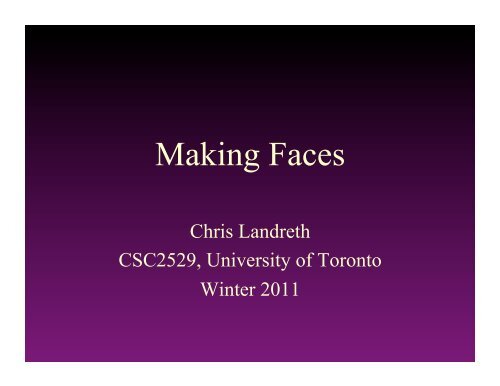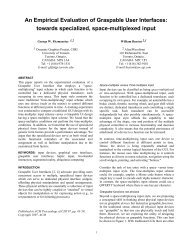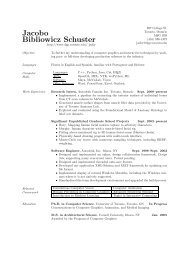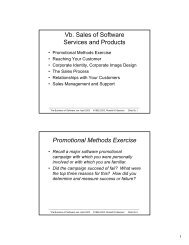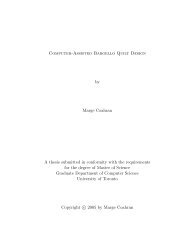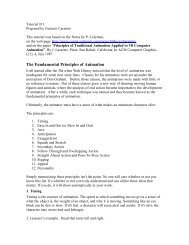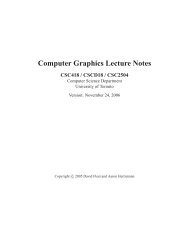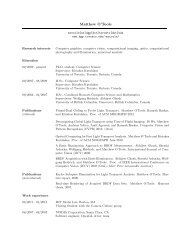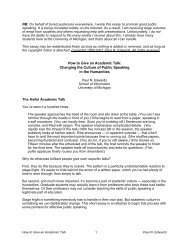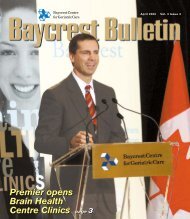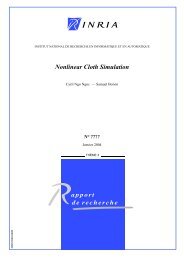When a person faces you straight-on, his/her head is roughly five ...
When a person faces you straight-on, his/her head is roughly five ...
When a person faces you straight-on, his/her head is roughly five ...
You also want an ePaper? Increase the reach of your titles
YUMPU automatically turns print PDFs into web optimized ePapers that Google loves.
Making Faces<br />
Chr<strong>is</strong> Landreth<br />
CSC2529, University of Tor<strong>on</strong>to<br />
Winter 2011
Which face bel<strong>on</strong>gs to Barack Obama?<br />
Most people can d<strong>is</strong>tingu<strong>is</strong>h even the world’s most famous Obama<br />
doppelganger from the U.S. president.
Who <strong>is</strong> t<strong>h<strong>is</strong></strong> <str<strong>on</strong>g>pers<strong>on</strong></str<strong>on</strong>g>?
Who <strong>is</strong> t<strong>h<strong>is</strong></strong> <str<strong>on</strong>g>pers<strong>on</strong></str<strong>on</strong>g>?<br />
What mood <strong>is</strong> she in?
We are hard-wired to recognize <str<strong>on</strong>g>faces</str<strong>on</strong>g><br />
and expressi<strong>on</strong>s—<br />
even from a football field away.
The Fusiform Gyrus:<br />
W<strong>her</strong>e the brain recognizes <str<strong>on</strong>g>faces</str<strong>on</strong>g>
The Inferior Temporal Gyrus:<br />
W<strong>her</strong>e the brain recognizes everything else
So refined <strong>is</strong> our facial acuity that we can:<br />
Recognize a <str<strong>on</strong>g>pers<strong>on</strong></str<strong>on</strong>g> after 40 years…
So refined <strong>is</strong> our facial acuity that we can:<br />
Recognize a <str<strong>on</strong>g>pers<strong>on</strong></str<strong>on</strong>g> after 40 years…
So refined <strong>is</strong> our facial acuity that we can:<br />
Sense when some<strong>on</strong>e <strong>is</strong> lying…
So refined <strong>is</strong> our facial acuity that we can:<br />
Tell the emoti<strong>on</strong> within, when nothing <strong>is</strong> happening…
So refined <strong>is</strong> our facial acuity that we can:<br />
See complex, human expressi<strong>on</strong> in a carto<strong>on</strong> f<strong>is</strong>h…
Goals of t<strong>h<strong>is</strong></strong> course:<br />
--Refine <str<strong>on</strong>g>you</str<strong>on</strong>g>r ability to see and read <str<strong>on</strong>g>faces</str<strong>on</strong>g>.<br />
--Learn the anatomy and psychology of the human face.<br />
--Rig an anatomically correct face of a CG character.<br />
--Animate t<strong>h<strong>is</strong></strong> character.<br />
--Use t<strong>h<strong>is</strong></strong> knowledge to advance the field of<br />
Facial Animati<strong>on</strong> in CGI.
Making Faces<br />
Part 1: The structure, anatomy and psychology<br />
of the face (four sessi<strong>on</strong>s)<br />
Class 1 (Jan 10): Observing and drawing the human <strong>head</strong><br />
Class 2 (Jan 17): Inside out, outside in: the skull<br />
Class 3 (Jan 24): Muscles and FACS (Facial Acti<strong>on</strong> Coding System)<br />
Class 4 (Jan 31): An introducti<strong>on</strong> to facial expressi<strong>on</strong>
Making Faces<br />
Part 2: C<strong>on</strong>structing a CG face (four sessi<strong>on</strong>s)<br />
Class 5 (Feb 28): Modeling the expressi<strong>on</strong>s with FACS<br />
Class 6 (Mar 7): Rigging the face part 1<br />
Class 7 (Mar 14): Rigging the face part 2<br />
Class 8 (Mar 21): The t<strong>on</strong>gue, speech and ph<strong>on</strong>emes
Making Faces<br />
Part 3: Animating a CG face (four sessi<strong>on</strong>s)<br />
Class 9 (Mar 28): Animati<strong>on</strong> part 1: doing nothing<br />
Class 10 (Apr 4): Animati<strong>on</strong> part 2: lipsynch<br />
Class 11 (Apr 11): Animati<strong>on</strong> part 3: acting with restraint<br />
Class 12 (Apr 18): Animati<strong>on</strong> part 4: going over the top
Making Faces<br />
Part 4: Final Projects<br />
Class 13 (Friday Apr 22): Final exerc<strong>is</strong>e--<br />
Animate a face doing 20 sec<strong>on</strong>ds of acting,<br />
with at least 5 sec<strong>on</strong>ds of speech<br />
Final Technical Comp<strong>on</strong>ent: A project <strong>on</strong> a mutually agreed up<strong>on</strong> topic<br />
that models, simulates or c<strong>on</strong>trols some aspect of facial animati<strong>on</strong> or<br />
workflow.
Recommended Readings:
Part 1:<br />
Seeing the Face
Basic Proporti<strong>on</strong>s of the Human Head<br />
The<br />
Rule<br />
of<br />
Equal<br />
Halves<br />
D<strong>is</strong>tance from<br />
eyes to the<br />
crown<br />
EQUALS<br />
D<strong>is</strong>tance from<br />
eyes to the chin
Basic Proporti<strong>on</strong>s of the Human Head<br />
The<br />
Rule<br />
of<br />
Equal<br />
Thirds<br />
Hairline to Brow<br />
EQUALS<br />
Brow to Nostrils<br />
EQUALS<br />
Nostrils to Chin
Basic Proporti<strong>on</strong>s of the Human Head<br />
The<br />
eyes:<br />
Equal<br />
fifths<br />
1 2 3 4 5<br />
<str<strong>on</strong>g>When</str<strong>on</strong>g> a <str<strong>on</strong>g>pers<strong>on</strong></str<strong>on</strong>g> <str<strong>on</strong>g>faces</str<strong>on</strong>g><br />
<str<strong>on</strong>g>you</str<strong>on</strong>g> <str<strong>on</strong>g>straight</str<strong>on</strong>g>-<strong>on</strong>, <strong>h<strong>is</strong></strong>/<strong>her</strong><br />
<strong>head</strong> <strong>is</strong> <strong>roughly</strong> <strong>five</strong> eyes<br />
wide.
Eggs and Crosshairs:<br />
C<strong>on</strong>structing the face from scratch<br />
Good drawings of a face start from 3 simple drawn objects: a midline, an eyeline, and<br />
a rough outline of the <strong>head</strong>—an egg shape.<br />
midline<br />
egg<br />
eyeline
Egg -> Head
V<strong>is</strong>ualizing the Eye<br />
The eye <strong>is</strong> pretty much a<br />
sp<strong>her</strong>e, about 26 mm in<br />
diameter. It sits <strong>on</strong> a pad of fat<br />
and muscles, embedded about<br />
halfway into the eye socket (ie.<br />
the Orbit).<br />
The lids of the eye form a<br />
curved surface <strong>on</strong> top of it.<br />
You can think of their structure<br />
as a bit like a knight’s helmet,<br />
w<strong>her</strong>e the upper lid <strong>is</strong> the<br />
helmet’s v<strong>is</strong>or.
V<strong>is</strong>ualizing the nose—fr<strong>on</strong>t view<br />
Think of the nose as a trapezoidal pr<strong>is</strong>m, wide at the base,<br />
narrow at its top. After <str<strong>on</strong>g>you</str<strong>on</strong>g> sketch in t<strong>h<strong>is</strong></strong> basic polyg<strong>on</strong>al<br />
shape, refine it by rounding out its features. The base<br />
gets rounded out to create the nose tips, then recessed <strong>on</strong><br />
both sides to create nostrils.
V<strong>is</strong>ualizing the nose—more arbitrary views
V<strong>is</strong>ualizing the mouth…<br />
The mouth presents a dizzying variety of shapes and sizes. Most important to get right <strong>is</strong> the<br />
“line between the lips” (LBL) when drawing a closed mouth.<br />
LBL<br />
LBL
Homework (for M<strong>on</strong>day Jan. 17):<br />
1. Do two drawings of “Block<strong>head</strong>” (from the<br />
quicktime movie provided <strong>on</strong> t<strong>h<strong>is</strong></strong> site.<br />
2. With a mirror, draw a self-portrait.


